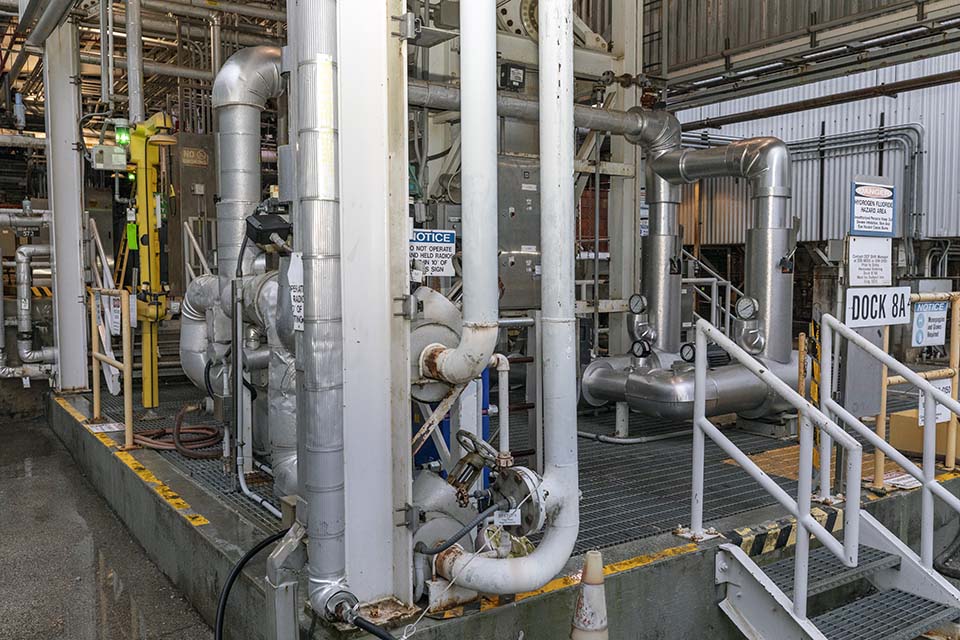HF removal at Y-12 reduces risk

The Oxide Conversion Facility will no longer be used for uranium recovery and purification.
Oak Ridge, Tenn.— Y‑12 National Security Complex has removed and shipped the final hydrogen fluoride (HF) cylinder, significantly reducing risk at the site. Removal of the hazardous chemical was part of the closure of the Oxide Conversion Facility (OCF) in Building 9212. The milestone eliminates a major contributor to Building 9212’s hazardous chemical profile and reduces the risk associated with the facility.
“We got rid of the hazard and the HF process,” said Jordan Webb, a Y‑12 supervisor. “We shut it down.”
The OCF was integral to processes used to recover and purify uranium. It converted purified uranium trioxide into the uranium tetrafluoride needed to create uranium buttons, which are used to cast components in support of Y‑12’s national security mission.
In total, 16 HF cylinders, with a yield of 6 runs each, had been used in the OCF since 2005, the year the facility was restarted after an accidental HF leak in 1992 shut down its operations.
HF is a toxic and corrosive chemical, and can have adverse effects on metal, glass, plant tissue, and more. “It reacts to everything, including the skin,” Webb said.
With the last cylinder gone, “we took the OCF to a safe state,” he said. “We’re capping the hydrogen piping to the facility and removing any uranium holdup in the piping and filters. That recovered uranium can be made into a usable form.”
After isolating hydrogen to the facility, the dock containing the HF equipment and the remainder of the OCF was placed in a safe state.
New process eliminates need for OCF
A new uranium process, electrorefining (ER), will replace the OCF, which used technology from the 1950s. ER uses molten salts in electrochemical processes to purify uranium. This process will produce purified uranium crystals, which will be melted in a furnace to create high‑purity uranium buttons for weapons work.
Argonne National Laboratory developed the ER process, and Y‑12 matured the technology for production purposes. The process is similar to known commercial processes used to purify aluminum, titanium, nickel, copper, and other metals.
In addition to reducing chemical hazards, ER also requires only one‑quarter of the floor space that OCF did. The process is also performed in inert gloveboxes, which establishes a new standard of worker safety and environmental protection. The ER Project is in its final stages and is expected to be operational in 2024.
Consolidated Nuclear Security, LLC operates the Pantex Plant, located in Amarillo, Texas, and the Y-12 National Security Complex, located in Oak Ridge, Tennessee, for the U.S. National Nuclear Security Administration. Bechtel National, Inc. is the lead member of CNS; minority members include Leidos, Inc.; ATK Launch Systems, LLC; and SOC LLC. Pantex and Y-12 are key facilities in the U.S. Nuclear Security Enterprise, and CNS performs its work with a focus on performance excellence and the imperatives of safety, security, zero defects, and delivery as promised.
For more information on each site, visit www.pantex.energy.gov or www.y12.doe.gov. Follow Pantex on Facebook, X or LinkedIn. Follow Y-12 on Facebook, X, and LinkedIn.
CONTACT
Kathryn King, APR
Communications
Office (865) 315.5996
Kathryn.King@pxy12.doe.gov
Follow Y-12 on Facebook, Twitter, YouTube and Flickr.
###
